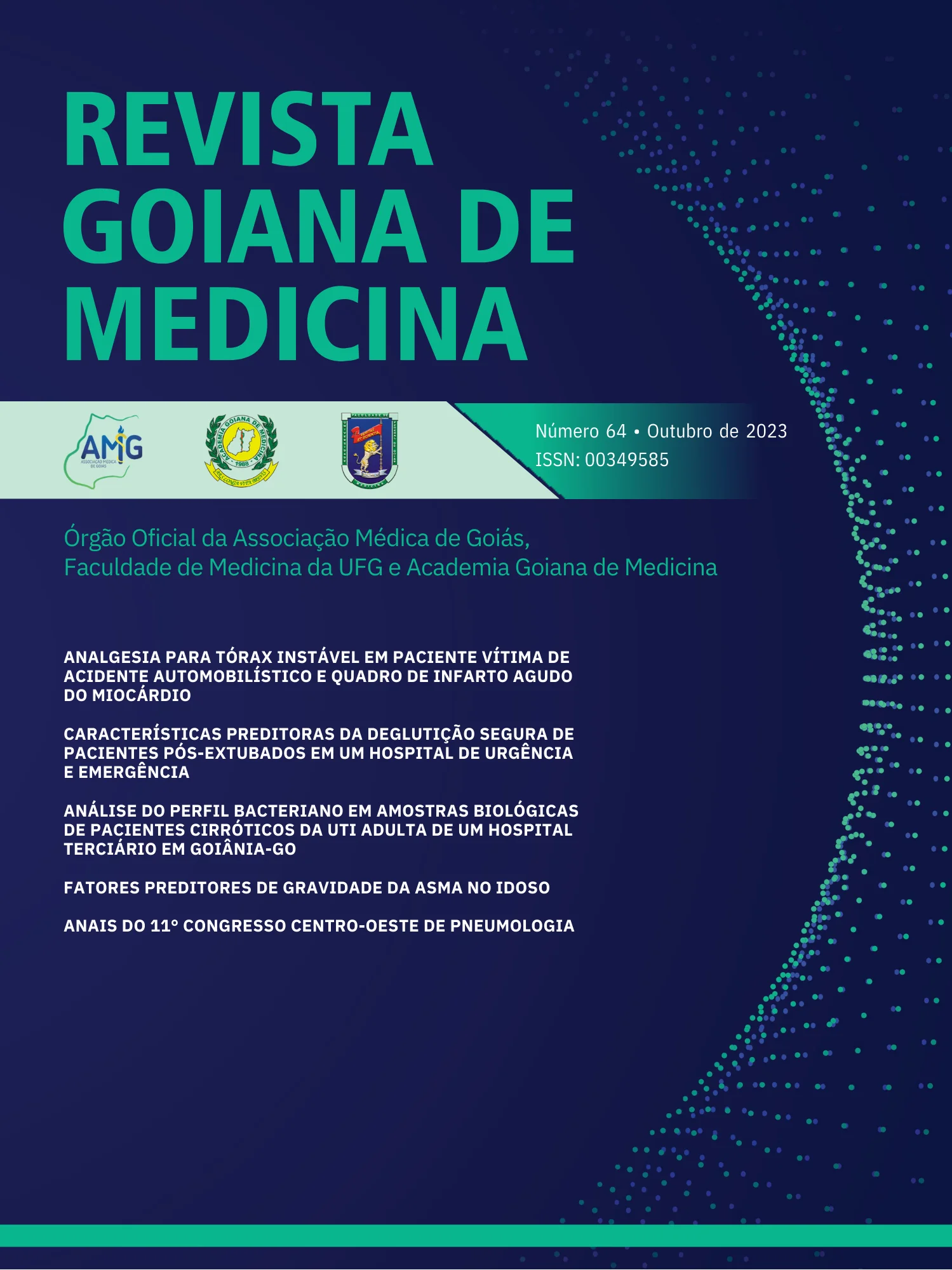The predictors of asthma severity in the elderly
Keywords:
Asthma, eldery, lung function, comorbiditiesAbstract
Objective: To evaluate differences in asthma in the elderly and non-elderly adults. Methods: cross-sectional study with retrospective data analysis of the OPENASMA longitudinal cohort. Data were collected from the medical records of adult patients with asthma recruited from the asthma outpatient clinic of the Hospital das Clínicas of the Federal University of Goiás, in Goiânia (GO) from August 2021 to June 2022. The study was approved by the Research Ethics Committee (CEP) of HC-UFG, and all participants signed the informed consent form. The significance level adopted was 5% (p < 0.05). RESULTS: 158 patients were included in the study, 60.1% adults and 39.9% elderly. The duration of illness in the elderly was significantly longer than in young adults (p < 0.01). 100% of the elderly had comorbidities, with hypertension and DM being the most prevalent. Drug treatment in the elderly included more frequent use of LAMA (39.7% of the elderly) and LABA (90.5% of the elderly) compared to younger adults (p < 0.01 and p = 0.03, respectively) . Exacerbations were significantly less frequent in the elderly (12.7%, p 0.01), but were more severe than in young adults (p = 0.02). Elderly people had lower FEV1 indexes pre and post bronchodilator (p = 0.03). Conclusion: There are significant differences between asthma in the elderly and in young adults, with a higher frequency of more severe exacerbations and worse lung function, in addition to comorbidities, which may indicate that they are predictors of more severe disease in this age group.
References
World Health Organization [homepage on the Internet]. Geneva: WHO; c2021 [cited 2021 May 1] Asthma- -Key Facts 2020. Available from: https://www.who.int/ en/news-room/fact-sheets/detail/asthma
Menezes AMB, Wehrmeister FC, Horta B, Szwarcwald CL, Vieira ML, Malta DC. Prevalência de diagnóstico médico de asma em adultos brasileiros: Pesquisa Nacional de Saúde, 2013. Rev Bras Epidemiol 2015; 18: 204-213
Global Initiative for Asthma.Global Strategy for Asthma Management and Prevention, 2023 Updated July 2023. Available from: http://www.ginasthma.org.
Yernault JC. Dyspnoea in the elderly: A clinical approach to diagnosis. Drugs and Aging 2001; 18: 177–187.
Tsai CL, Delclos GL, Huang JS, Hanania NA, Camargo CA. Age-related differences in asthma outcomes in the United States, 1988-2006. Annals of Allergy, Asthma and Immunology 2013; 110: 240-246.e1.
Brasil, Ministério da Saúde. Banco de dados do Sistema Único de Saúde-DATASUS. Disponível em http://www. datasus.gov.br [Acessado em 8 de outubro de 2023].
Brasil. Ministério da Saúde. Secretaria de Atenção Primária à Saúde. Departamento de Gestão do Cuidado Integral. Guia de cuidados para a pessoa idosa [recurso eletrônico] / Ministério da Saúde, Secretaria de Atenção Primária à Saúde, Departamento de Gestão do Cuidado Integral. — Brasília: Ministério da Saúde, 2023.
Harris PA, Taylor R, Minor BL, Elliott V, Fernandez M, O´Neal L, McLeod L, Delacqua G, Delacqua F, Kirby J, Duda SN, REDCapConsorium. The REDCap consortium: Building an international community of software partners.J Biomed Inform 2019; 95: 103208.
Harris PA, Taylor R, Thielke R, Payne J, Gonzalez N, Conde JG. Research electronic data capture (REDCap) – A metadatadriven methodology and workflow process for providing translational research informatics support.J Biomed Inform 2009; 42:377-81.
Khosa JK, Louie S, Moreno PL, Abramov D, Rogstad DK, Alismail A, Matus MJ, Tan LD. Asthma Care in the Elderly: Practical Guidance and Challenges for Clinical Management-A Framework of 5 “Ps.” Journal of Asthma and Allergy 2023; 16: 33–43.
Hubbard R, Tattersfield A, Smith C, West J, Smeeth L, Fletcher A. Use of inhaled corticosteroids and the risk of fracture. Chest 2006; 130: 1082–1088.
Nanda A, Baptist AP, Divekar R, Parikh N, Seggev JS, Yusin JS, Nyenhuis SM. Asthma in the older adult. Journal of Asthma 2020; 57: 241–252.
Pizzichini MMM, Carvalho-Pinto RM, Cançado JED, Rubin AS, Neto AC, Cardoso AP, Cruz AA, Fernandes ALG, Blanco DC, Vianna EO, Junior GC, Rizzo JA, Fritscher LG, Caetano LSB, Pereira LFF, Rabahi MF, Oliveira MA, Lima MA, Almeida MB, Stelmach R, Pitrez PM, Cukier A. Recomendações para o manejo da asma da Sociedade Brasileira de Pneumologia e Tisiologia. J Bras Pneumol 2020;46:e20190307
Lowery EM, Brubaker AL, Kuhlmann E, Kovacs EJ. The aging lung. Clinical Interventions in Aging 2013; 8: 1489–1496.
Mozaffarian D, Benjamin EJ, Go AS, Arnett DK, Blaha MJ, Cushman M, Ferranti S, Després J-P, Fullerton HJ, Howard VJ, Huffman MD, Judd SE, Kissela BM, Lackland DT, Lichtman JH, Lisabeth LD, Liu S, Mackey RH, Matchar DB, McGuire DK, Mohler ER, Moy CS, Muntner P, Mussolino ME, Nasir K, Neumar RW, Nichol G, Palaniappan L, Pandey DK, Reeves MJ, Rodriguez CJ, Sorlie PD, Stein J, Towfighi A, Turan TN, Virani SS, Willey JZ, Woo D, Yeh RW, Turner MB. Heart Disease and Stroke Statistics—2015 Update. Ciculation 2015; 131: e29-e322.
Bellary S, Kyrou I, Brown JE,Bailey CJ. Type 2 diabetes mellitus in older adults: clinical considerations and management. Nature Reviews Endocrinology2021; 17: 534–548.
Yawn BP, Han MK. Practical Considerations for the Diagnosis and Management of Asthma in Older Adults. Mayo Clinic Proceedings 2017; 92:1697–1705.


